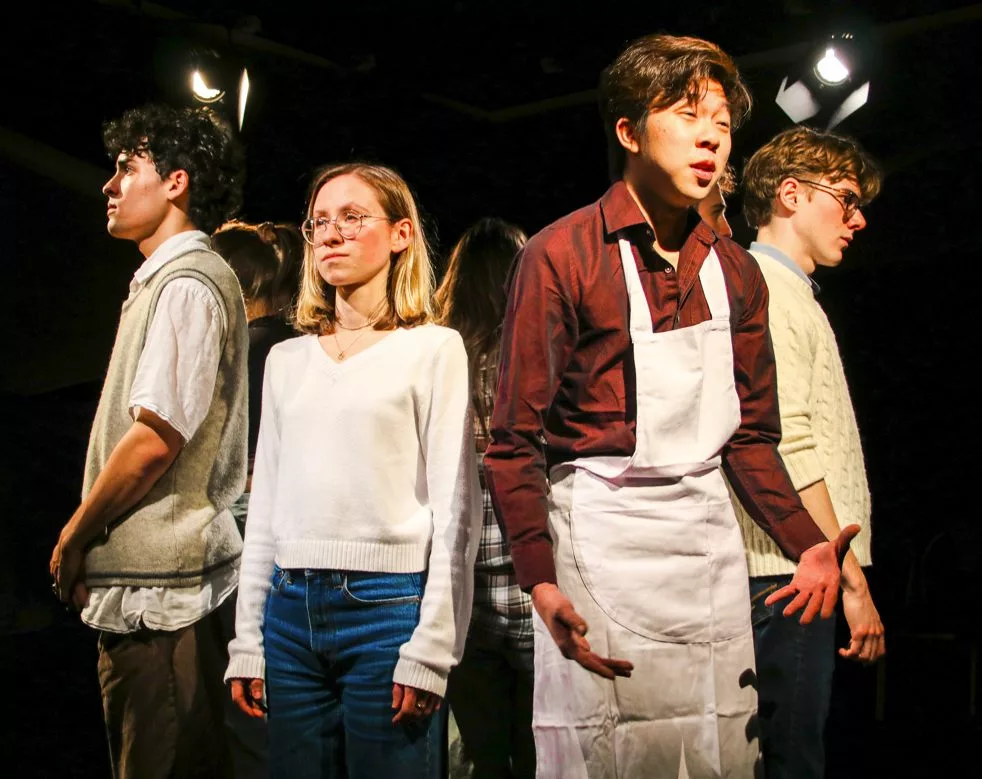A full-moon shaped circle of chairs awaits the audience. We’re directed to stand in the middle of the circle and one by one, characters step on chairs and surround us, and each time someone new speaks, the collective sway of our heads reminds me of a back-and-forth tennis match. The set itself is intimate, with stars dotted around the ceiling and a giant papier-mâché moon looming high on one side of the studio. All of this is telling: This is How We Walk on the Moon is not a play to be observed but to be immersed in.
Seven personal truths told in the form of carefully crafted monologues, it’s not at first obvious that there are seven different writers behind the scenes. Of course, the characters mostly do not interact or seem aware of each other’s existence, each delivering an earnest monologue from somewhere deep-seated in their distinct personal histories. But the script is hardly sporadic patchwork as one may expect when there are so many writers- it flows with a purpose, and what are at first unrelated storylines begin to merge.
KFC Lover’s (Wong Man Shun) newfound pining for a co-worker draws parallels to the love that Eli (Felix Kerrison-Adams), the romantic poet, has been professing in devoted rhyme for the first half of the play. The reaction of loved ones to Midnight Pirate’s (Susie Weidmann) grand voyage fantasies reflects those who constantly undermine Jodie’s (Juliette Imbert) physical pain from fibromyalgia, telling her it’s all in her head. And perhaps Ammonite’s (Ethan Bareham) fixation with the fact we’re all standing on such an ancient planet compares to Jealous Bitch (Hope Yoon) and Hairdresser Dave’s (Cosimo Asvisio) obsessive storytelling.
Despite seven unique personalities to convey, the stellar cast all hold their own. In particular, I’m compelled by KFC Lover’s story. He has been traumatised at the hand of his near-evil boss, burned by a steamer. Four small holes are branded into his arm as if he needed any more reminding. It’s clear that the damage done by the burns- physical and mental- are constant, maybe even irreparable, and yet, he stays at his job, now yearning for tenderness and affection from his new co-worker Dani. It’s painfully realistic, but the script also left room for humour, the occasional KFC quips providing the break for some comedic relief.
Each character’s story is halted by the introduction of another’s – cautious glimpses are offered into their minds, more withheld for gradual reveal- but the play is far from disjointed. They’re held together by one common glue- the all-too-human desire to at last be understood. It’s as if when one person starts speaking, another is finding ways to relate. Each character endures varying levels of alienation and isolation, but as Ammonite reminds us, we’re all suffering the same human experience on this planet, alive at the same time.
While there is no clear happy ending, there is a feeling of closure by the climax and final moments of the play. Without noticing, the characters had become my friends, secrets and pain spilling out after being swallowed down too long, and finding their vulnerability was not met with judgement but the understanding they’d longed for: this is how we co-exist. Even when we think, ‘Oh no, the sky is falling’- maybe there is someone out there for us.



